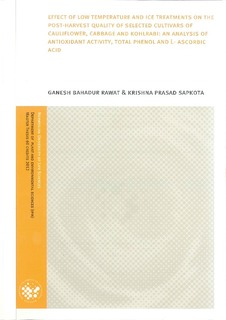| dc.description.abstract | Brassica, the only vegetable crop attributed with the potential to protect cancer and cardiovascular diseases were investigated in present study. The antioxidant activity, total phenol and L-ascorbic acid in 3 selected cultivars of cauliflower, cabbage and kohlrabi grown in Ås Norway (59°40’N) were stored at 0 °C, 5 °C and ice for 6-7 weeks. Antioxidants were analyzed by FRAP Assay in Konelab, total phenols by Follin-Ciocalteu’s phenol Reagent (FCR) in Konelab and L-ascorbic acid by HPLC. Overall, the low temperature enhanced the postharvest quality of selected vegetables. There was a variation in the content of antioxidant from 0.19-0.78 mmol/100g FW, 0.22-1.92 mmol/100g FW and 0.30-0.45 mmol/100g FW in cauliflower, cabbage and kohlrabi respectively where the exceptionally highest value was observed in ice stored red cabbage cv. Rovite (1.92 mmol/100g FW). The total phenol in the present study as a part of antioxidant was found to be varying from 39.14-85.39 mg GAE/100g FW, 29.12-166.89 mg GAE/100g FW and 26.81-42.27 mg GAE/100g FW in cauliflower, cabbage and kohlrabi respectively. Here, the dramatically high total phenol among the studied Brassica was noticed in Rovite stored in ice storage condition. Among treatments, the antioxidant activity and total phenolics increased at both 0 °C and 5 °C storage conditions in cauliflower while they did not significantly increase in cabbage and kohlrabi. Unlike 0 °C and 5 °C, the storage treatment in ice exhibited mixed effects with significant increase in the amount of antioxidant activity and total phenol in cauliflower cultivars (Flamenco and Celio) and cabbage cultivars (Castello and Rovite) or no significant increase in cauliflower cv. Nemo, cabbage cv. Bartolo or even decrease in kohlrabi cultivars. In the same way, L-ascorbic acid was ranging from 51.62-75.18 mg L-asc/100g FW, 32.77-46.27 mg L-asc/100g FW and 25.93-39.02 mg L-asc/100g FW respectively in cauliflower, cabbage and kohlrabi; with the highest value in cauliflower (Celio) at 0 °C. The analysis of L-ascorbic acid at different treatments in cauliflower cultivars illustrated that ice was the best storage condition though it decreased significantly in Celio. Meanwhile, L-ascorbic acid content decreased in cabbage and kohlrabi cultivars during storage except red cabbage (Rovite) where it increased significantly. Moreover, the variation in the content of dry matter in cauliflower, cabbage and kohlrabi ranged from 5.54-8.56%, 5.85-9.61% and 3.93-5.70% respectively; with a highest value in Bartolo cabbage at harvest and depicted a declining trend over storage among all the crops under study. The two-way Anova analysis and Turkey’s LSD for the treatment means revealed that the low temperature treatment of 0 °C was the best storage condition for the selected Brassica vegetables as it reduces the ongoing metabolism to the minimum. The present study thus suggests that this low temperature treatment preferably 0 °C can be used to commercially store Brassica vegetables. | no_NO |
